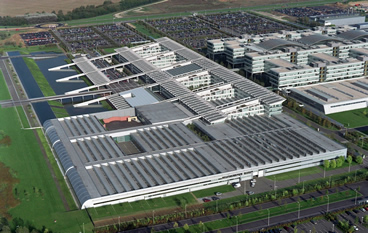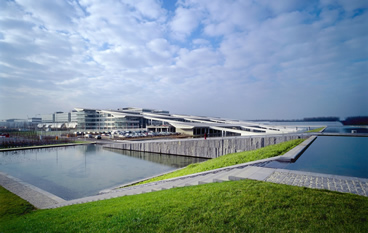Renault Technocentre celebrates tenth anniversary
17 Jun 2008|2,830 views
 |  |
This large-scale technological and architectural project was developed to provide Renault with benchmark status in automotive design and development. It offers its 11,500 resident employees cutting-edge resources for carrying out their projects effectively in an ultra-modern, environmentally-friendly atmosphere.
At the Technocentre, vehicle development is undertaken in a comprehensive manner and production methods are designed along with the vehicles themselves. Digital technology makes it possible to conduct ten or so projects simultaneously.
The Technocentre is a key contributor to the growth and international development of the Renault Group, a goal whose importance has intensified with the implementation of Renault Commitment 2009.
Average saving of approximately €150 million on each new vehicle developed
After undergoing a period of reorganisation in both its structure and work methods, Renault decided to bring all of its geographically dispersed Research and Development units (engineers, management and technical staff) together in a single site - the Technocentre.
Its 11,500 staff members work on every phase of a project, from preliminary studies through to the latest prototype ready for assembly on the production line. Their wide-ranging goals include placing innovation at the heart of design and development, making constant strides in quality, cutting costs and lead times and promoting the globalisation of Renault Group models.
Today, manufacturers are renewing and updating their model ranges to anticipate the increasingly demanding requirements of customers. Renault released eight passenger cars between 1945 and 1965, 17 from 1965 to 1985, 14 in the 1985-1997 period and 14 between 1997 and 2005. In the context of Renault Commitment 2009, 26 new vehicles will be launched in the 2006-2009 period.
This ever-accelerating tempo of range renewal means that development lead times must be even shorter, and the proximity of the various Technocentre units to each other contributes significantly to making this possible. Cross-functional project management also enables rapid decision-making.
Production ramp-up lead times have also been cut - by two-thirds since the founding of the Technocentre. This achievement, and its continued improvement, are largely dependent on the quality of the work performed in the design and development phase and the close contact of the various units assigned to product and process engineering. Similarly, in the domain of powertrains (engines and gearboxes) - an equally important area with the same concerns regarding coherence - the development resources available have all undergone reorganisation on their long-established sites (Rueil in particular). Their goals are the same as for the Technocentre, especially in relation to development costs and lead times, with a 30% reduction as their set objective.
Thanks to the Technocentre, Renault has benefited from an average saving of €150 million in development costs for each new vehicle.
 |  |
This large-scale technological and architectural project was developed to provide Renault with benchmark status in automotive design and development. It offers its 11,500 resident employees cutting-edge resources for carrying out their projects effectively in an ultra-modern, environmentally-friendly atmosphere.
At the Technocentre, vehicle development is undertaken in a comprehensive manner and production methods are designed along with the vehicles themselves. Digital technology makes it possible to conduct ten or so projects simultaneously.
The Technocentre is a key contributor to the growth and international development of the Renault Group, a goal whose importance has intensified with the implementation of Renault Commitment 2009.
Average saving of approximately €150 million on each new vehicle developed
After undergoing a period of reorganisation in both its structure and work methods, Renault decided to bring all of its geographically dispersed Research and Development units (engineers, management and technical staff) together in a single site - the Technocentre.
Its 11,500 staff members work on every phase of a project, from preliminary studies through to the latest prototype ready for assembly on the production line. Their wide-ranging goals include placing innovation at the heart of design and development, making constant strides in quality, cutting costs and lead times and promoting the globalisation of Renault Group models.
Today, manufacturers are renewing and updating their model ranges to anticipate the increasingly demanding requirements of customers. Renault released eight passenger cars between 1945 and 1965, 17 from 1965 to 1985, 14 in the 1985-1997 period and 14 between 1997 and 2005. In the context of Renault Commitment 2009, 26 new vehicles will be launched in the 2006-2009 period.
This ever-accelerating tempo of range renewal means that development lead times must be even shorter, and the proximity of the various Technocentre units to each other contributes significantly to making this possible. Cross-functional project management also enables rapid decision-making.
Production ramp-up lead times have also been cut - by two-thirds since the founding of the Technocentre. This achievement, and its continued improvement, are largely dependent on the quality of the work performed in the design and development phase and the close contact of the various units assigned to product and process engineering. Similarly, in the domain of powertrains (engines and gearboxes) - an equally important area with the same concerns regarding coherence - the development resources available have all undergone reorganisation on their long-established sites (Rueil in particular). Their goals are the same as for the Technocentre, especially in relation to development costs and lead times, with a 30% reduction as their set objective.
Thanks to the Technocentre, Renault has benefited from an average saving of €150 million in development costs for each new vehicle.
Latest COE Prices
May 2025 | 2nd BIDDING
NEXT TENDER: 04 Jun 2025
CAT A$102,501
CAT B$116,988
CAT C$63,189
CAT E$118,010
View Full Results Thank You For Your Subscription.
















